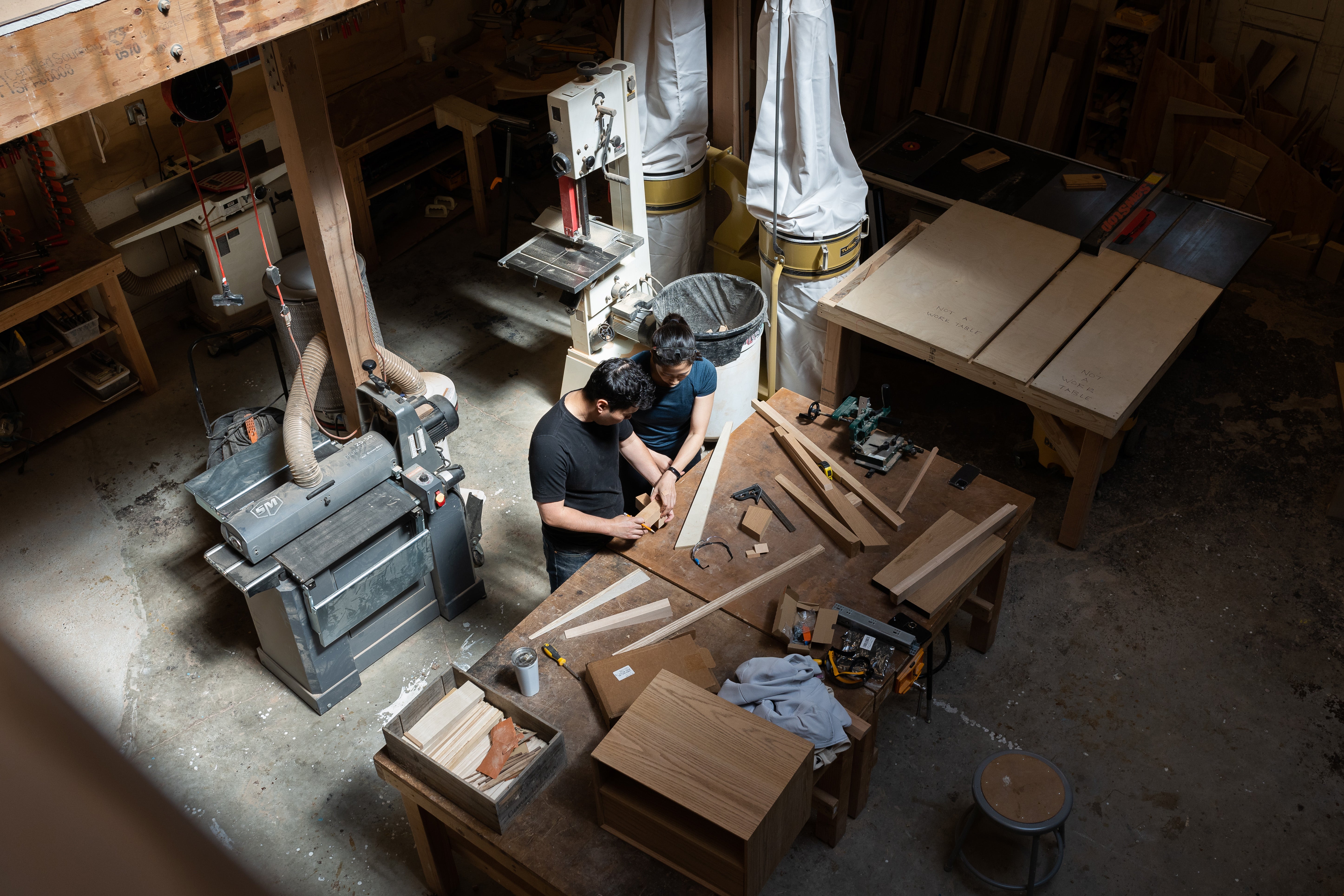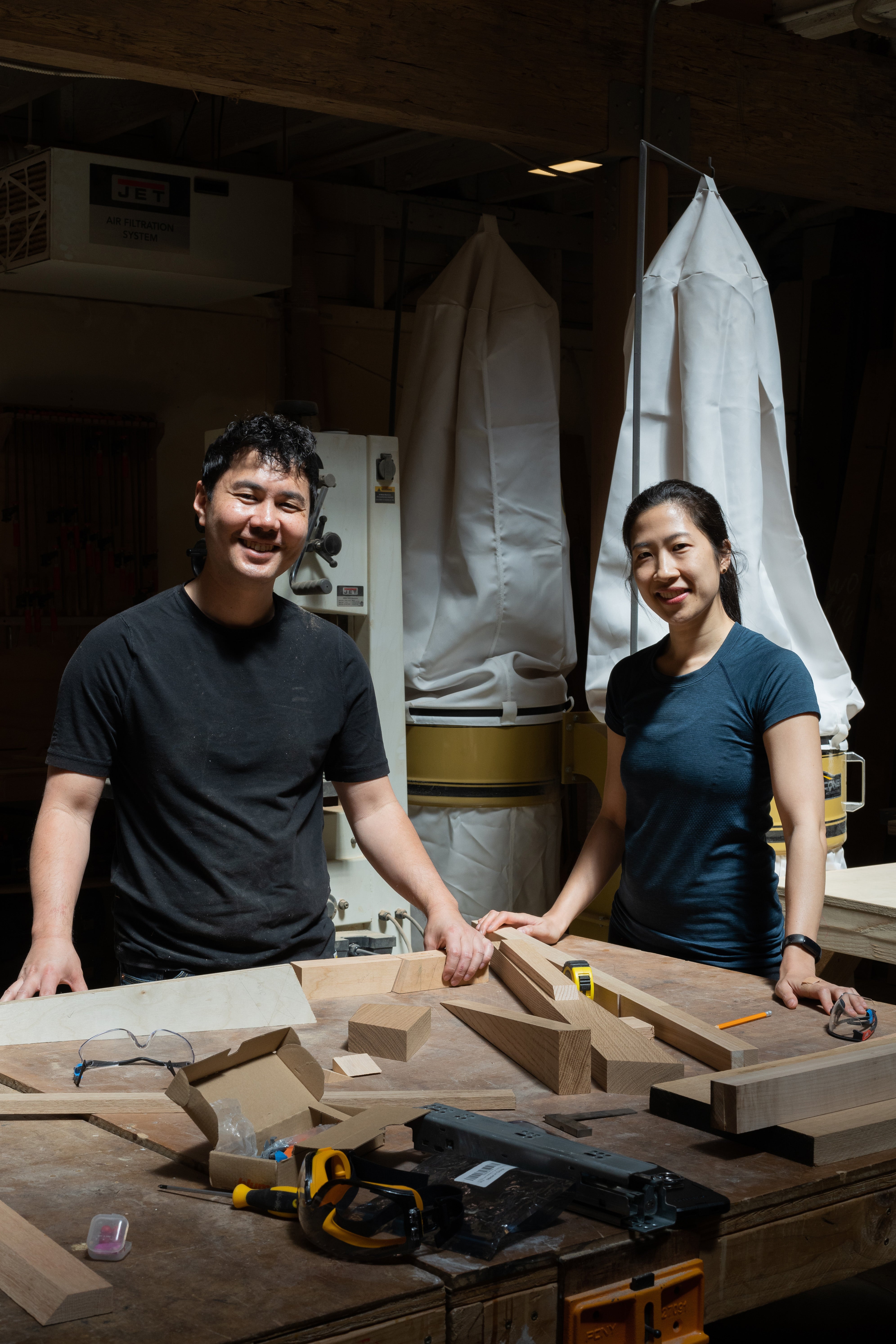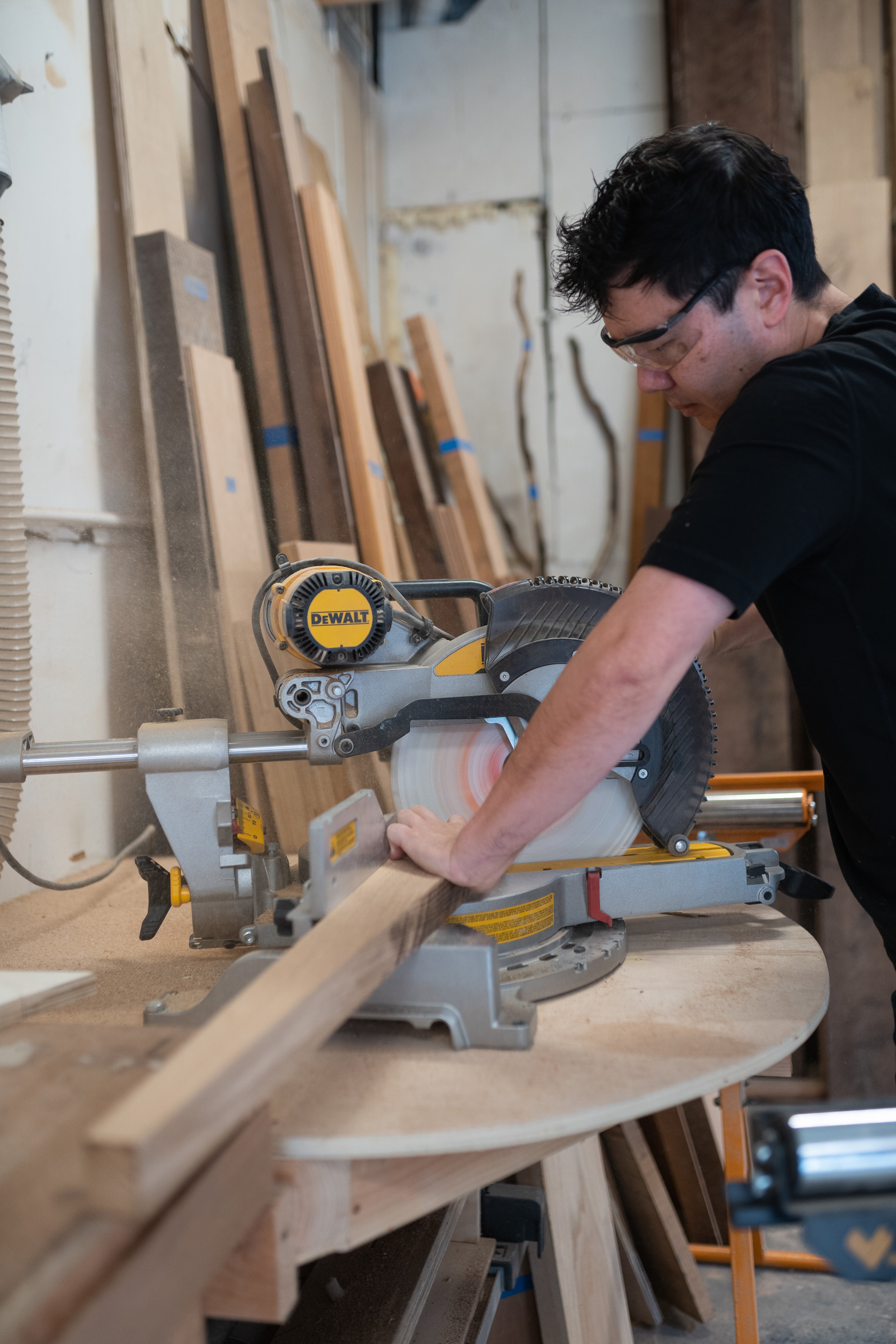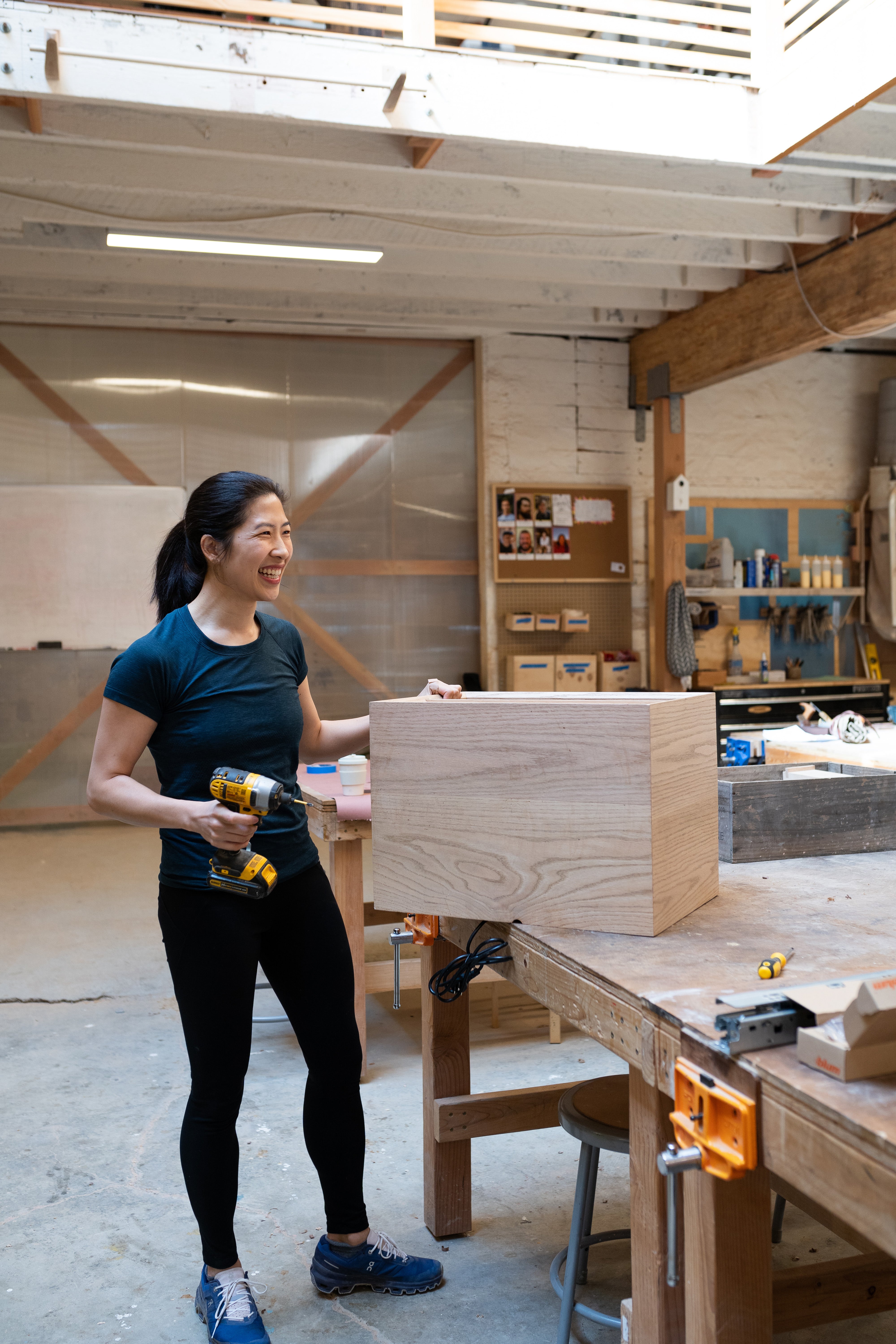They built the digital world. Now they just want to sew and make chairs
Those who came up in the ‘move fast and break things’ era are learning to slow down and make things, writes Lisa Bonos

On a typical workday, Haomiao Huang spends most of his time on Zoom calls, perusing spreadsheets and pitch decks, and trying to make smart decisions about which robotics and hardware start-ups to fund and which to skip.
He has also spent months, together with his wife, practising an ancient woodworking technique where two pieces of wood are meant to interlock seamlessly. After each failed attempt, these amateur woodworkers toss another expensive piece of white oak into their scrap pile.
“We’re patient,” says Lydia The after carefully running a piece of wood through a table saw. “We’re making the dining table we’re going to die with.”
Huang, 40, and The, 37 – who works in the pharmaceutical industry – could easily walk into an upscale furniture store near the wood shop where they’re toiling on a Saturday, and spend $4,000 (around £3,200) on a table that’s already constructed. But like many modern workers who are tethered to digital devices all day, Huang and The are hooked on the stress relief – and the sense of connection and accomplishment – that comes from working with their hands.
“It’s tremendously grounding, and it’s meditative,” Huang says of the time he spends in the wood shop. By day, Huang is a venture capitalist at Kleiner Perkins, a powerful Silicon Valley firm that invested early in such tech giants as Amazon, Google, Twitter and Uber. “When you have a power saw, you can’t think about the financing that isn’t coming together. If I don’t hold it in a particular way, I’m going to lose my hand.”

In tech’s boom times, many sought to “move fast and break things”, a motto Mark Zuckerberg popularised at Facebook and blossomed into a growth-at-all-costs ethos that spread throughout Silicon Valley. Now, in an era of layoffs and cost-cutting, workers feel an urge to slow down and make things.
Woodworking shops have sprung up around the city in recent years, catering to those wanting to work with their hands. Start-ups schedule classes to team-build, and workers for two tech giants say there are places to woodwork on campus (the companies didn’t confirm or deny).
“Tech workers never believe me when I tell them to do it the slower way. They do it the faster way and mess it up,” says Jake Klingensmith, a 31-year-old part-time software engineer who runs the wood shop at Clayroom, a large space in the Soma neighbourhood with a ceramics studio in the front.
The interest in cultivating handiwork skills goes beyond wood. The maker movement, where people use do-it-yourself techniques to construct things, has been flourishing in the Bay Area for about a decade. In the pandemic, some tech workers rekindled their Lego obsessions. Glassblowing, welding, pottery-making and other art forms have also taken off.
The Meta CEO Mark Zuckerberg recently posted on Facebook about how he learned to sew while helping his daughters construct dresses out of 3D-printed material.
The venture capitalist Arielle Zuckerberg, one of Mark’s younger sisters, and several others recently convened 40 friends at a Lake Tahoe compound for Learning Man. The weekend, complete with custom swag, was a studious play on Burning Man; attendees taught one another how to sew, DJ, whip up the perfect French omelette and more.
“Even tech workers are not just passionate about tech,” said Zuckerberg, who shared her DJ skills with attendees. When Zuckerberg learned how to sew a Learning Man patch on to her Patagonia vest, she “had this deep sense of accomplishment, and it was so incredibly satisfying”. She enjoyed it so much, she bought a sewing machine.
That’s also a big part of the attraction of woodworking, says Neil Gershgorn, 37, who owns Clayroom. A software engineer, for example, can publish code and then debug it as long as necessary. Whereas, Gershgorn notes that “if you make a mistake with your chisel, it’s completely done.”

However, these hobbies are not cheap – woodworking classes cost hundreds of dollars, a studio membership plus materials quickly balloons into the thousands, further catering to the elite nature of tech world, where engineers draw salaries in the hundreds of thousands of dollars. Compared with other pandemic hobbies such as bread-baking and racket sports, “woodworking has a slightly higher barrier of entry in terms of tools and access,” Klingensmith says. Huang and The estimate that they’ve spent about $10,000 (around £8,000) on woodworking classes, their studio membership and materials.
Working slowly and deliberately can be difficult for people who are trained to focus on speed and efficiency.
Sharmila Lassen, a 60-year-old retired software engineer, says during a recent class at Clayroom that the experience is as much a lesson in patience as it is in woodworking. When she tried to “optimise” – tech jargon for making a process as efficient as possible – by stacking two pieces of wood on top of one another, she then had to even out her imprecise cuts. Overall, she’ll spend $300 (£239) and 12 hours to construct a small serving tray.
Lassen’s friend, Alison Jones, a senior vice president at an architecture and engineering firm, joins her for the serving-tray class. “I came in here with a headache,” Jones says, but working in the wood shop calms her. “I like learning how to be competent at something,” she adds. “At the end of it – look, I have this thing,” she says, holding up her tray, “instead of a spreadsheet.”
“When you’re doing woodworking, you’re tapping into a history of human craftsmanship that’s been around for the entire existence of our species,” Klingensmith notes.

Enthusiasts find the hobby to be a good match for a downturn, when many are out of work or are deliberately taking time off. John Szot, a 30-year-old who moved from Manhattan to the Bay Area recently, finds woodworking to be a “nice change of pace” while he takes a break from working in finance. He finds opportunities to work with his hands are “increasingly rare”.
Szot also came to the wood shop in part to meet people, as he’s new to the area.
While about half of the country’s white-collar workers have returned to the office, tech giants are among the few remaining holdouts, and office vacancies in downtown San Francisco are at an all-time high – so high some offices are being converted to apartments.
As people spend less time commuting, they have more time for hobbies, and more of a need for connection, Gershgorn says. There is “this kinetic energy that happens when you come into the studio post-five o’clock,” Gershgorn adds, when mitre saws are whirring and lathes are turning as people work on disparate projects side-by-side.
Chris Steinrueck, the 38-year-old owner of Wood Thumb, another wood shop in the neighbourhood, finds the hobby to have a certain rejuvenating power for desk workers who spend most of their day staring at electronic devices.
Wood Thumb frequently has groups from nearby tech companies coming by for one-time classes that double as team-building exercises. When people come in for a class, “you can just tell they’re zonked,” Steinrueck says, likening their demeanour to that of a “robot zombie”. By the end of a class where participants have made cutting boards or a small triangle shelf, he notices that “everybody is just pumped and excited – and there’s life in the room.”
Huang and The got into the wood shop in part because they were looking for a new way to connect. The hobby is “a great bonding experience for us,” Huang says.
The couple has a rule where, if one person gets burned out finishing something, the other takes the project over the finish line. When The needs a new piece of wood with notches to anchor a nightstand on the wall, Huang jumps in to construct it. And when Huang feels defeated from trying to master the difficult angles of a bridle joint for the dining table they are making, The swoops in.
On a recent Saturday, instead of hacking into a piece of wood that could have been a table leg, they are going back to the basics and building a prototype. Making a model with scrap wood is advice Klingensmith gave them that has taken a while to sink in.
“I’m very close,” The says to Huang, proudly holding up a mortise and tenon after running the wood through a table saw.
Huang suggests using the power sander to round out the edges till they fit together smoothly.
“Then I’ll end up going too fast,” she reasons. “It’s so close. Just a little more patience.”
She takes out a chisel, then sandpaper. After nearly 30 minutes of tinkering, the two pieces of wood fit together. It’s not perfect – there are small gaps between the two pieces – but it’s nothing a little glue can’t fix.
© The Washington Post
Subscribe to Independent Premium to bookmark this article
Want to bookmark your favourite articles and stories to read or reference later? Start your Independent Premium subscription today.






Join our commenting forum
Join thought-provoking conversations, follow other Independent readers and see their replies
Comments